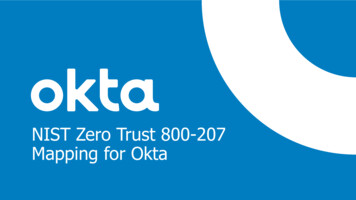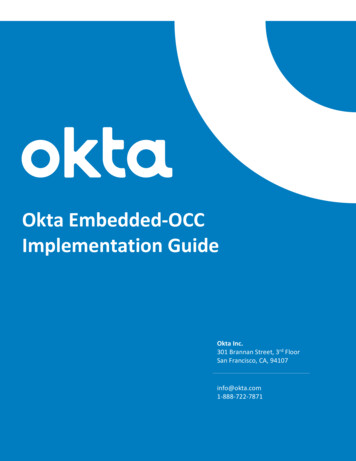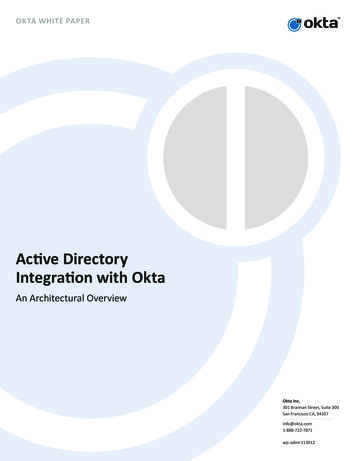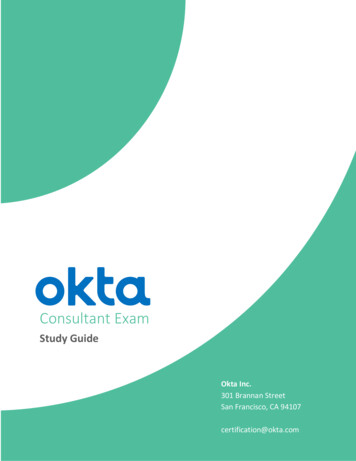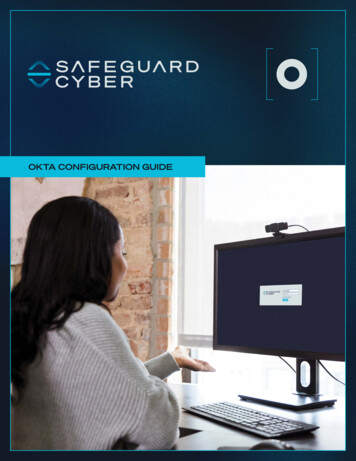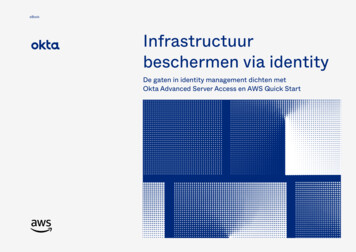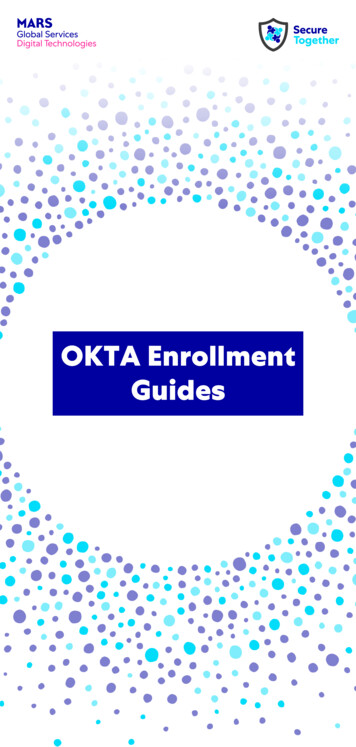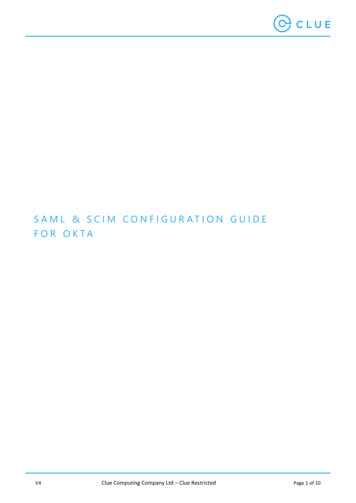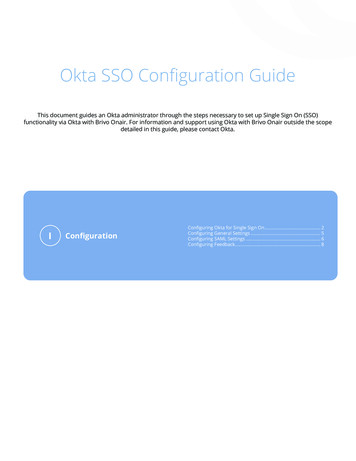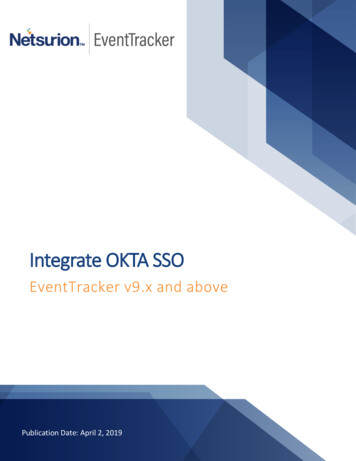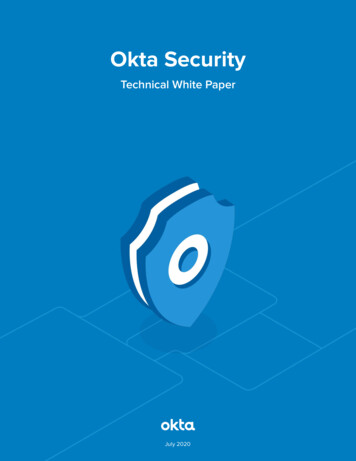
Transcription
Okta SecurityTechnical White PaperJuly 2020
IndexIntroduction5Okta and Service Security7About Okta8Okta Identity Cloud Platform8Workforce Identity9Customer Identity10Okta’s Approach to Security11Shared Security Responsibility Model11Okta’s Responsibility: Security of the Cloud12Your Responsibility: Security in the Cloud12Okta Security Controls13Introduction14Infrastructure/Physical Security14Physical Security16Data Centers16Okta Offices16Compute Security17Instance Level Security17Fault Separation to Improve Reliability17Data Security (Data-at-Rest Security)17Network Security (Data-in-Transit Security)18Availability and Performance Monitoring19Personnel Security19Secure Personnel Practices19Before Hiring20Upon Hiring20While Working for Okta20When Departing Okta20Least Privilege Access Policy21Okta Security Technical White Paper2
Software Development Security21Development Practices21Software Development Lifecycle22Business Prioritization & Planning23System Design23Development24Tests24Release24Service-Level SecurityOkta’s Encryption Architecture25251.Users’ Access to Okta262.Access to Single Sign-On Apps and APIAuthorization263.Tenant Data at Rest274.Tenant Keys at Rest275.Keystore Storage and Segregation276.Master Key Encryption28Tenant Data Security29Tenant Data Segregation29Confidential Data Encryption29Password Encryption29Tenant Network Segregation and Security31Network Separation31Custom Domains and Certificates31Session Context Validation31Tenant Performance Segregation32Tenant Feature Set Segregation32Web Application Security Controls33Code33Access to Okta33Okta Security Technical White Paper3
Application and Database Controls During Runtime34Okta Security Personnel34Service-Level Availability and Performance Monitoring35Security and Penetration Tests36Compliance37Introduction38Okta Service Certifications38ISO 27001:201338ISO 27018:201938SOC 2 Type II Certification38Cloud Security Alliance Security, Trust, & Assurance Registry(CSA STAR)39FedRAMP—Authority to Operate (ATO)39How Okta Helps You Meet Compliance Requirements39HIPAA39PCI-DSS 3.239Sarbanes Oxley (SOX)39GDPR40NYDFS40Resources41Security Documentation42Okta Solution Briefs42Okta Security and Availability42Universal Directory and Lifecycle Management43Multi-Factor Authentication43SSO and Integrations43Compliance and Regulation44Books and Publications44Third-Party Resources44Conclusion45Okta Security Technical White Paper4
Introduction“There is a massive shift happening right now towardsidentity-centric security. The arc of technology haslong bent towards securely enabling workforces inany environment, but as organizations adapt to newways of working and servicing consumers, the trendhas only accelerated. Whether you’re using Okta tosecurely enable your workforce or to deliver seamlesscustomer experiences, we understand that our ownsecurity posture is a significant area of focus for you.As the world's leading independent identity platform,we know what information security best practices looklike and in this document, we’ve outlined theprinciples that guide our direction and the protectionswe have built encompassing our technology andpersonnel. We hope you find it valuable and we lookforward to continuing to partner with you.– DavidOkta Security Technical White PaperBradbury Chief Security Officer, Okta5
Identity and Access Management and Information Security are mission-critical functions in modernorganizations. Our customers trust Okta to safely connect people to technology. That trust requires aservice that is highly available and secure.As an Okta customer, you benefit from a service designed, built, maintained, and monitored to meetthe rigorous Confidentiality, Integrity, and Availability requirements of the most security-sensitiveorganizations and industries.This document provides an introduction to Okta’s approach to managing security throughout thefollowing chapters: Okta and Service SecurityProvides an overview of Okta, the Okta Identity Cloud Platform, the Okta’s approach tosecurity, and the shared security model. Okta Security ControlsLists some of the major security controls implemented and leveraged by Okta to safeguardyour data and to maintain the service’s confidentiality, integrity, and availability. ComplianceLists the security certifications achieved by Okta’s Identity Cloud Platform and how Okta canhelp you achieve security certifications and comply with specific industry regulations. Learn MoreProvides additional resources about Okta security and how you can strengthen yoursecurity posture by leveraging the Okta Identity Cloud Platform.Okta Security Technical White Paper6
Okta and ServiceSecurity“Okta has demonstrated, not just to us, but toindustry analysts and security experts that theytake security very seriously, and that it’s aservice that we’ll be able to trust.– Den Jones, Senior Manager of IT ms/Okta Security Technical White Paper7
About OktaOkta is the market-leading Identity Cloud provider. Our independent platform securely connects the rightpeople to the right technologies at the right times.The Okta Identity CloudThe Okta Identity Cloud is the Identity as a Service (IDaaS) platform built and maintained by Okta.As a true cloud-native service—100% born and built in the cloud, Okta provides key benefits:It’s globally available, 100% multi-tenant, stateless, and redundant.It’s regularly updated with security enhancements and new features.It has zero planned downtime, since we update the platformon-the-fly and don’t schedule downtime for maintenance.It drastically reduces operational tasks and setup and maintenance costs.It’s subscription-based and cost-flexible.The benefits above are rarely found in on-premise software, managed cloud services, or at vendors thatported legacy on-premises software to the cloud.The Identity Cloud Platform features include both Workforce and Customer Identity products.Okta Security Technical White Paper8
Workforce IdentityWorkforce Identity products are geared toward IT and security leaders. At a very high level, they simplifythe way people connect to enterprise technology, while increasing efficiency and helping keep ITenvironments secure. These solutions include:Universal DirectoryCustomize, organize and manage any set of user attributes from multiple identitysources with this flexible, cloud-based user store.Single Sign-OnFree your people from the chains of multiple passwords. A single set of credentials givesthem access to enterprise apps in the cloud, on-prem and on mobile devices.Lifecycle ManagementAutomate user onboarding and offboarding by ensuring seamless communicationbetween directories such as Active Directory and LDAP, and cloud applications such asWorkday, SuccessFactors, Office 365 and RingCentral.Adaptive Multi-Factor AuthenticationSecure your apps and VPN with a robust policy framework, a comprehensive set ofmodern verification factors, and adaptive, risk-based authentication that integrates with allof your apps and infrastructure.With Workforce Identity, IT enjoys one central place for policy-based management that governs whichusers get access to the mission-critical applications and data that power core business processes.Employees benefit from a single sign-on home page that simplifies their lives and reduces security riskscaused by “password fatigue.” With Okta, they no longer resort to risky practices for memorizingpasswords—for example, by choosing obvious or reused passwords, writing passwords down on Post-itnotes, or saving them in Excel files on their laptops.Okta Security Technical White Paper9
Customer IdentityCustomer Identity products allow you to embed Okta as the identity layer of your apps or customize Oktain order to:Deliver Customizable User ExperienceLeverage Okta APIs and widgets to create fully-branded login flows or end-userportals. You can even use our APIs to build a custom admin experience wherecustomers or division managers can manage their users.Extend Okta to Any Use CaseSolve any complex identity integration, data or automation challenge by taking advantageof Okta’s broad APIs. Run scripts to modify user data, automatically integrate apps orintegrate with custom workflows.Leverage the Best-in-Class Customer IAM (CIAM) SolutionFree your developers to focus on the customer experience and leave identity to Okta.Leverage Okta as an “identity API” for all your app dev projects, with Okta handlingauthentication, authorization and user management.Customer Identity products provide programmatic access to the Okta Identity Cloud, enabling yourdevelopers to build great user experiences and extend Okta in any way you can imagine. By poweringcustomer identity for your digital business, we can solve your most complex enterprise architecturechallenges.Enterprises that adopt the Okta service dramatically improve the security and experience for usersinteracting with their applications—whether they be employees, contractors or customers, using a cloudservice, on-premise application, VPN, firewall, custom app, etc.Okta Security Technical White Paper10
Okta’s Approach to SecurityThe Okta Identity Cloud is designed, built, maintained, monitored, and regularly updated withsecurity in mind.To deliver our service with consistent confidentiality, integrity and availability to everycustomer—regardless of their industry, size, products used, etc., Okta operates under a sharedsecurity responsibility model.Shared Security Responsibility ModelThe shared security responsibility model is a framework adopted by many cloud providers—includingAmazon AWS, Microsoft, and Salesforce—to identify the distinct security responsibilities of the customerand the cloud provider. In this model: Okta is responsible for the security of the cloud. You are responsible for the security in the cloud based on your company's information securityrequirements.Customer Application & ContentYou get to secure yourtenant in the CloudTenant and Service SettingsService SecurityOkta takes care of thesecurity of the CloudInfrastructure & Physical SecurityOkta’s shared security responsibility modelOkta Security Technical White Paper11
Okta’s Responsibility: Security of the CloudOkta is responsible for the security “of” the Okta Identity Cloud Platform underlying infrastructure.Okta is also responsible for providing features you can subscribe to in order to secure what you hostin Okta.The section below on Okta Security Controls lists some of the major controls we’ve implemented andleveraged to ensure the security of the cloud.Your Responsibility: Security in the CloudOur customers are responsible for securing what they host “in” Okta. This includes, for example,granting the correct permissions to your users, disabling accounts when employees are terminated,enforcing multi-factor authentication, properly configuring and monitoring the authentication policiesrequired to protect your data, reviewing activity data in the system log to ensure users are followingyour policies, and monitoring your Okta tenants for attacks, such as password spraying, phishing, etc.In our To Learn More section, you can find resources that will help you fulfill your responsibilitiesusing Okta.Okta Security Technical White Paper12
Okta SecurityControls“Okta plays a role in all three of my initiatives:Cyber security, business productivity, and bestof breed. It fits all three, so it’s a perfect match.– Gus Shahin, CIOhttps://www.okta.com/customers/flex/Okta Security Technical White Paper13
IntroductionAs a cloud provider, Okta is responsible for the security “of” the Okta Identity Cloud Platform includingour service's underlying infrastructure.Some of the major security controls we use to secure our cloud service infrastructure include: Infrastructure/Physical Security Personnel Security Software Development Security Service-Level Security Security and Penetration TestsInfrastructure/Physical SecurityThe Okta technical team has deep experience in developing and operating market-leading cloudservices. Okta drew on that experience to select an infrastructure provider that can scale and supportOkta’s security and availability requirements.Amazon AWS is that partner. Amazon runs one of the largest cloud platform services and hassignificant expertise in building, operating and maintaining the worldwide infrastructure required topower that business. Since early 2006, AWS has provided companies of all sizes with a platform thatpowers business applications of tremendous scale.Okta Security Technical White Paper14
Okta leverages this infrastructure and adds security controls on top of Amazon AWS:Amazon AWSResourcesOkta implementssecurity controls on itsservice layer with focuson identity as a serviceOkta fine tunes andimplements additionalcontrols on top of AWSinfrastructure securityAmazon AWSimplements securitycontrols on itsservice infrastructureOkta delivers identity as a service and extended security capabilities on top of AWS We run our workloads on Amazon AWS. We leverage the AWS infrastructure and native security. We fine-tune and configure additional security controls in AWS with security in mind. In addition, we implement additional security controls on our service layer, focused onIdentity-as-a-Service needs. This allows us to deliver a secure and reliable service.Infrastructure security—operated collectively by Okta and Amazon AWS as described in the nextsections—starts with physical security, extends through the computer, network and storage layers ofthe service, and is complemented by well-defined security and access policies with ongoing audit andcertification by third parties.Okta Security Technical White Paper15
Physical SecurityOkta leverages AWS’ physical security for access to its physical servers and implements physicalsecurity controls in our own offices. This security strategy aims to preserve the confidentiality, integrityand availability of our services from physical threats.Data CentersAWS data centers are housed in nondescript facilities, where physical access is strictly controlled both atthe perimeter and at building ingress points by professional security staff utilizing video surveillance,state-of-the-art intrusion detection systems and other electronic means. Authorized staff use multi-factorauthentication mechanisms to access data centers, and all physical access by employees is logged andaudited routinely.Data center access and information is only provided to employees and contractors who have alegitimate business need for such privileges, and when an employee no longer requires these privileges,their access is immediately revoked—even if they continue to be an Amazon employee. All visitors andcontractors are required to present identification before being signed in and continuously escorted bystaff.Okta OfficesOkta also applies physical security controls in its own offices. These measures include, among others: Access control and audit trail for employees and visitors Video monitoring of all entrance and exit points Delimited security perimeters with additional security for places such as storage rooms, powerand AC rooms, and loading areas 24/7/365 security personnel on premises Employee awareness training Periodic testing of physical security controlsOkta Security Technical White Paper16
Compute SecurityOkta customizes its AWS Elastic Cloud Compute (EC2) instances and its Virtual Private Cloud (VPC)infrastructure to ensure security is maintained on multiple levels: The virtual instance operating system or guest OS The firewall and signed API callsWe also maintain secure isolation at the instance level, and leverage AWS’ Availability Zones to improveservice availability.Instance Level SecurityMulti-factor authentication is required for administrative access to host operating systems for instancemanagement. These administrative hosts’ systems are specifically designed, built, configured andhardened to protect the management plane of the cloud. Okta logs and audis all such access. AWS hasno access rights to our guest OS environments, which are locked down and completely controlled byOkta administrators.Okta has also configured the firewall to enable only those ports required for our application—all otherports are disabled. In addition, only our front-end application components are Internet accessible. Allother access to the Okta production infrastructure requires a VPN connection.Fault Separation to Improve ReliabilityOkta improves reliability by leveraging Amazon features to place instances within multiple geographicregions, as well as across multiple Availability Zones. Each Availability Zone is designed with faultseparation and physically separated across typical metropolitan regions (each on different floodplainsand in seismically stable areas). The Amazon Data Center controls page describes several faultseparation controls implemented for AWS’ Availability Zones.Data Security (Data-at-Rest Security)Okta makes multiple investments to ensure our customers' data is secure and available. As detailed inthe Service-Level Security section below, customer data, and access to it, is isolated at the customerlevel within Okta’s data layer. Physically, that data is stored using the AWS Elastic Block Storage (EBS)service. To meet Okta’s one-hour recovery point objective, database snapshots of EBS volumes aretaken regularly and stored in AWS’ S3 storage service. Access to S3, even within AWS, requiresencryption, providing additional insurance that the data is also transferred securely.Okta Security Technical White Paper17
Within AWS S3, we restrict access at both the bucket and object level, and only permit authenticatedaccess by the bucket and/or object creator—Okta. Authenticated users’ read/write permissions arerestricted by a combination of bucket and object access control lists (ACLs), bucket policies, and theirIAM-derived access grants. We audit all bucket-level access and all data retrieval object-level access.Furthermore, Okta has targeted monitoring of S3 and VPC traffic for suspicious activity. Alerts are sent inreal-time to the Okta Security Team.Network Security (Data-in-Transit Security)The AWS network provides protection against traditional network security issues, including: Distributed denial of service (DDoS) attacksAWS network infrastructure leverages proprietary DDoS mitigation techniques developed asa result of running the world’s largest online retailer. Additionally, AWS’s networks aremulti-homed across a number of providers to achieve Internet access diversity. Man in the middle (MITM) attacksAmazon EC2 virtual machines (VMs) automatically generate new SSH host certificates onfirst boot and log them into the instance’s console. Okta leverages secure APIs to accessthe host certificates before logging into an instance for the first time. IP spoofingAmazon EC2 VMs running the Okta service cannot send spoofed network traffic. TheAWS-controlled, host-based firewall infrastructure does not permit an instance to send trafficwith a source IP or MAC address other than its own. Port scanningUnauthorized port scans of EC2 customers are a violation of the Amazon EC2 AcceptableUse Policy (AUP). Violations of the AUP are taken seriously, and every reported violation isinvestigated. When unauthorized port scanning is detected, it is stopped and blocked. Portscans of Amazon EC2 instances are ineffective because, by default, all inbound ports onAmazon EC2 instances are closed. Packet sniffing by other tenantsIt is not possible for a virtual instance running in promiscuous mode to receive or “sniff”traffic that is intended for a different virtual instance. Even two virtual instances that arelocated on the same physical host cannot listen to each other’s traffic. Attacks such as aaddress resolution protocol (ARP) cache poisoning do not work within Amazon EC2.Okta complements AWS network security with specific security controls for its service. These securitycontrols are described in detail on the section Service-Level Security.Okta Security Technical White Paper18
Availability and Performance MonitoringWe monitor each server in the Okta environment for machine health metrics twice per minute to trackavailability. These metrics include standard items such as network connectivity, CPU utilization, memoryutilization, storage utilization, service status and key file integrity. Failures generate alerts that are pushedto our operations staff through prioritized channels.Okta also collects trending data for per-server and per-service performance metrics, such as networklatency, database query latency and storage responsiveness. We track this performance for end-to-endscenarios across the application as a whole. Okta assigns health thresholds to each of these metrics, anduses the same alerting mechanism as for our machine-level availability monitoring described above. Weuse additional instrumentation in our runtime environment to collect metrics internal to the application.Okta not only invests in internal monitoring, but also publishes real-time and historical data on our publicmonitoring and alerting system at trust.okta.com. To learn more about this, see the Service-LevelSecurity section of this document.Personnel SecuritySecurity starts with the people Okta employs. We implement security controls for employees andcontractors before, during and after their tenure at Okta.Secure Personnel PracticesBefore Hiring Background checkWhile working for Okta Continuous awareness training Continuous access review Continuous social engineering testsUpon Hiring Proprietary information &inventions agreement Onboard trainingWhen departing Access revocation Contract obligations remindOkta’s ongoing personnel security controlsOkta Security Technical White Paper19
Before HiringBefore hiring, all employees and contractors undergo background checks where permitted bylaw. The background check reviews both criminal and financial background indicators andincludes a credit check for senior finance positions.All new hire references, both requested and non-requested, are carefully scrutinized. Employeesand contractors are made aware of their responsibilities, plus operational and security policies,as well as repercussions for failure to adhere to said responsibilities and policies.Our SOC 2 Type II audit report provides third-party attestation regarding the efficacy of Okta’sbackground check procedures and policies. This document is available for review under NDA.Upon HiringUpon hiring, all employees and contractors go through an onboarding process that includes: Signing a Proprietary Information & Inventions Agreement (PIIA).The PIIA states the confidentiality obligations as an Okta employee or contractor. Completing the employment onboard and security awareness training. This traininghelps new hires understand their security responsibilities as an Okta employee orcontractor, as the case may be.Our SOC 2 Type II audit report provides third-party attestation regarding the efficacy of Okta’sbackground check procedures and policies. This document is available for review under NDA.While Working for OktaSecurity awareness training is an ongoing educational process throughout employment withOkta that helps employees and contractors understand their responsibilities over dataprotection.In addition, Okta’s security team performs progressive social engineering tests and awarenesscampaigns to build security into the culture of the company.When Departing Okta All Okta employees and contractors are reminded of their confidentiality obligationsupon leaving.Their user accounts, passwords, hardware, and badges are revoked within a stricttime frame.Okta Security Technical White Paper20
Least Privilege Access PolicyOkta requires that all access to its infrastructure, application, and data be controlled based on businessand operational requirements. Following the principles of segregation of duties and least privilege, codechanges and maintenance are split between multiple teams. The operations team is responsible formaintaining the production environment, including code deploys, while the engineering team developsfeatures and code in development and test environments only. This ensures multiple employees arerequired to deploy any code into production. In all cases, administrative access is based on the conceptof least privilege; users are limited to the minimum set of privileges required to perform their requiredjob functions.Software Development SecurityThe Okta Software Development Lifecycle is designed with precautions to reduce security risks duringcode development while delivering software functionality.Okta’s application development follows rigorous processes and adheres to much of the Open WebApplication Security Project’s CLASP (Comprehensive, Lightweight Application Security Process)concepts. Feature requests, bugs, and code enhancements are triaged and processed for threatmodeling and risk analysis. Developed code is peer- and security-reviewed prior to final commit andquality assurance (“QA”) validation. All developed code must have unit test code developed for testrelease as well. Okta’s QA team performs automated testing to validate all unit, regression,performance, and stress tests, as well as web and mobile application penetration testing.For optimal results, the software development security controls are implemented before and during thesoftware development.Development PracticesOkta continuously trains its developers on secure development practices. In addition to the standardsecurity personnel practices, developers have: An onboarding training required for all new engineers. Training sessions enable new Oktadevelopers to learn and practice Application Security. A quarterly technical training provided by the security team. Training is also recorded and availablefor viewing to engineers that are unavailable to attend in person. Training includes learning aboutsecurity vulnerabilities and prevention of exploiting vulnerabilities in the application.Okta Security Technical White Paper21
The continuous training helps to ensure developers will provide adequate protection for the varioustypes of potential attacks are identified, such as: Malformed input SQL injection Cross-Site Scripting (XSS) Cross-Site Request Forgery (CSRF) Broken Authentication and Session Management Insecure Direct Object References Security Misconfiguration Sensitive Data Exposure Other Open Web Application Security Project Top 10 threats (OWASP’s Top 10)Software Development LifecycleThe Okta software development lifecycle uses an iterative approach to development by leveraging theAgile/Scrum Agile/Scrum iterative software development lifecycleOkta Security Technical White Paper22
The iterative approach concentrates on producing frequent new versions of the software in incremental,short cycles. The process loops round with each of the stages being carried out many times in smalliterations (in the Agile method these are called “Sprints”).This results in small incremental releases with each release building on previous functionality. Eachrelease is thoroughly tested to ensure software quality is maintained.In Agile, development testing is performed in the same iteration as programming.Because testing is done in every iteration—which develops a small piece of the software—users canfrequently use those new pieces of software and validate the value.Okta incorporates security into various stages within the Software Development Lifecycle.Business Prioritization & PlanningDuring this phase, Product and Engineering Management plan and set priorities on new service features,components, or functionalities. The business requirements may specify: The value of the information involved The criticality of the new service and the information it holds The legal, regulatory and contractual environment the system must operate withinIf any potential security impact is identified, Product Management and Engineering will engagewith the Security team to identify the security and compliance requirements that the newfeature/component/service will adhere to in order to hold and process information.The security requirements are carried out through the feature design, development, testing,deployment, and maintenance.System DesignDuring the design phase, the solution must present the appropriate security controls to address thesecurity and compliance requirements set during the planning.Okta Security Technical White Paper23
DevelopmentDuring the development phase, a secure development environment is provided for each developer.This includes the physical laptop configuration from IT and the Development coding environment.Depending on the coding environment, languages, databases, tools and other components selected,the appropriate guidelines for secure coding and configuration are adopted.When a developer is ready to merge the code into an integration branch, they are responsible forgetting a code review. Other developers assess the code for compliance, security, performance, andlogical correctness. If there is security impact, the Security team is included in the unit test process.In addition, the Security team perform its independent assessment of upcoming code releases todetermine features requiring focused reviews. Based on risk, the reviews range from automated codeanalysis to deep manual code reviews and penetration tests.TestsDuring the lifecycle of a software application, many different forms of testing will be carried out,including unit, functional and security tests.The testing process includes over 60,000 tests including: Continuous Integration (CI) for building, testing and deploying new code Instrumented tests in different environments and browsers Unit and
Availability and Performance Monitoring Personnel Security Secure Personnel Practices Before Hiring . PCI-DSS 3.2 Sarbanes Oxley (SOX) GDPR NYDFS Resources Security Documentation . integrity and availability to every customer—regardless of their industry, size, products used, etc., Okta operates under a shared .
